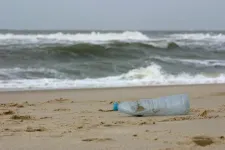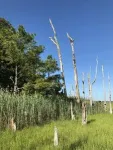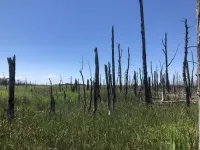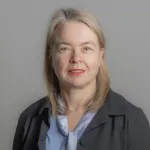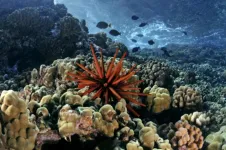Citizen scientists help discover microplastics along the entire German coastline
The AWI's citizen science project "Microplastic Detectives" has analyzed 2.2 tons of sand from German coasts for microplastics
2024-09-25
(Press-News.org) The global production of plastics and the resulting plastic waste has increased to such an extent that plastics have become ubiquitous in our environment. Plastics of various sizes are also found along the German North Sea and Baltic coasts. Previous studies of microplastic pollution on German beaches have often been limited to a few locations. In the citizen science project “Microplastic Detectives”, researchers from the Alfred Wegener Institute, together with citizens, have now collected samples from beaches along the entire German coast to be analyzed for microplastics. The resulting dataset is the first to be large enough to make reliable estimates of the state of pollution along the entire German coastline. The team is publishing its findings in the journal Frontiers in Environmental Science.
Global plastics production could almost triple by 2060, according to estimates by the Organisation for Economic Co-operation and Development (OECD). This leads to more plastic waste and a build-up of plastic in water bodies, where it breaks down into microplastics - particles smaller than or equal to five millimeters. “This irreversible plastic pollution is affecting species, populations and ecosystems, including along the German coast,” says Dr Bruno Walther, formerly of the Alfred Wegener Institute, Helmholtz Centre for Polar and Marine Research (AWI), now at Heinrich Heine University Düsseldorf and lead author of the recently published study. The extent to which our beaches in the North Sea and Baltic Sea are polluted has so far only been assessed for individual areas or locations, but not for the entire German coast. “This is why we launched the citizen research project 'Microplastic Detectives' to collect comparable data on the large-scale distribution of microplastic pollution along the German coastline.”
With the help of citizen scientists, the research team was able to collect a total of 2.2 tons of sand from 71 locations along the German coast, covering a total area of 68.36 square meters. “We have combined a total of 1139 comparable samples into one large dataset. That's more geographic coverage than we’ve ever had before,” says co-author and AWI biologist Dr Melanie Bergmann. The samples were then dried at the AWI, sieved and analyzed under a microscope for plastic particles as small as one millimeter in size. “In this study, we deliberately focused on large microplastics in order to rule out airborne contamination with small microplastic particles and to simplify sampling for the citizen scientists.”
The results were surprising: “Although we found plastic on 52 out of 71 beaches, the amount of large microplastics in the North Sea and Baltic Seas was lower than in other studies,” explains Bruno Walther. “If we had also analyzed smaller microplastic particles, we would certainly have found much higher concentrations,” adds Melanie Bergmann. In previous AWI studies in the North Sea and the Arctic, microplastics smaller than one millimeter accounted for over 90 per cent of the microplastics found in sediments. “We also randomly selected sampling sites on the beach, rather than focusing on accumulation areas such as drift lines.” This may also explain differences.
Of the 1139 samples analyzed, 177 contained a total of 260 plastic particles. This is an average of about four plastic particles per square meter. On a ten-hectare beach, that would be 400,000 plastic particles. However, the analysis also shows that microplastic pollution varies greatly from place to place.
How effective are policies, and where do policies need to be re-adjusted?
“Our study is the first to provide comparable data on the large-scale distribution of plastic pollution along the entire German coast using standardized methods,” emphasizes Melanie Bergmann. This is necessary, for instance, to be able to map the status quo against the success of future policies to limit plastic pollution. For example, monitoring results suggest that legislative changes may have led to fewer plastic bags being found on the seafloor in north-west Europe over the past 25 years. “But we need stronger, science-based policies that set binding rules on how we avoid, reduce and recycle plastics.” This would include measures to limit the production and use of plastics to essential applications, to ban hazardous ingredients, to increase degradability in nature and thereby enable the circular use of fewer resources.
“Microplastic Detectives” also shows that monitoring programs that involve citizens to collect comprehensive and timely data collection are successful. Interest in supporting science to tackle plastic pollution is huge: “We were surprised by the number of citizen scientists who enthusiastically spent several hours on the beach, diligently collecting, packing and sending samples. We would like to express our heartfelt thanks for this,” says Bruno Walther. “The ideal outcome of our project would be, to use it as a blueprint for long-term and even more intensive monitoring of microplastics pollution on German beaches,” adds Melanie Bergmann. “This is the only way we can review and adapt the measures we urgently need to turn the tide on plastics and their negative impacts on our coastal environment, tourism and human health.” The “Microplastic Detectives” project has now come to an end. However, citizens can still get involved in campaigns such as the Plastic Pirates citizen science project, which has school children collecting data on plastic pollution on coasts and rivers.
END
ELSE PRESS RELEASES FROM THIS DATE:
2024-09-25
Sunlight filters through the canopy of pines, holly, sweet gum, and red maple while bird calls echo in the distance. These coastal forests may seem like others in the Mid-Atlantic, but a hidden challenge looms. Standing tall next to their salt marsh neighbors, where the wind carries the sharp scent of sulfidic seawater, these trees are more than just part of the landscape—they are living monuments to a rapidly changing environment. As sea levels rise, the future of these forests is uncertain. While the adjacent salt marshes can adapt to encroaching waters, the trees, vulnerable to the increasing frequency ...
2024-09-25
Noise from aircraft at night is linked with disturbed sleep quality and sleep-wake cycle, a new study using movement trackers has shown.
Environmental health experts at the University of Leicester combined measurements from activity monitors and self-reported sleep information for the first time to put together a more detailed picture of how aircraft noise impacts sleep, in the largest such study to date.
The results, published in Environmental Health Perspectives, show that people exposed to higher levels of night-time aircraft noise experienced more restlessness during sleep and disruption in daily sleep rhythm, even if they had a full night’s sleep.
The team was led from the ...
2024-09-25
If you’d stopped monitoring the Adriatic Sea’s marine life in the mid-20th century, the outlook would have been promising. Snails and the clams they hunt for food increased in abundance for several decades during the late 1800s and early 1900s, evidence of a vibrant and healthy ecosystem.
Then, a threshold was crossed. Populations of both predator and prey abruptly plummeted and in some cases disappeared entirely. They were replaced by the common corbulid clam (Varicorbula gibba), which has the ability to slow down its metabolism in unfavorable conditions. Whenever paleontologists find an abundance of this species in the marine fossil record, it often means ...
2024-09-25
KANEOHE, HI (Sept 24, 2024 1:05 p.m. HST)- In a study published today in Proceedings of the Royal Society B, researchers at the UH Hawaiʻi Institute of Marine Biology (HIMB) Toonen- Bowen “ToBo” Lab have identified scenarios under which eight of the most common species of coral found in Hawaiʻi can adapt to and survive ocean warming and acidification. The corals in the study are prevalent throughout the Indo-Pacific, a region that comprises more than two-thirds of the coral reefs on planet Earth, and were found to be capable of surviving a “low ...
2024-09-24
Around 1 in 3 children and teens around the world is short (near)-sighted, with the global prevalence of myopia set to top 740 million cases by 2050 in this age group, finds a pooled data analysis of the available evidence, published online in the British Journal of Ophthalmology.
Female sex, East Asian or urban area residence, and educational level all seem to be key factors influencing prevalence, the findings indicate.
Short (near)-sightedness (myopia), which describes difficulty seeing objects at a distance, typically starts in early childhood and tends to worsen with age, explain the researchers. It has emerged ...
2024-09-24
The huge and growing toll bottled water is taking on human and planetary health warrants an urgent rethink of its use as 1 million bottles are bought every minute around the globe, with that figure set to rise further still amid escalating demand, warn population health experts in a commentary published in the open access journal BMJ Global Health.
Some 2 billion people around the world with limited or no access to safe drinking water rely on bottled water. But for the rest of us, it’s largely a matter of convenience and the unshaken belief—aided and abetted by industry marketing—that bottled water is safer and often healthier than tap ...
2024-09-24
Women in the UK, and elsewhere, are still missing out on vital treatment for their No 1 killer—cardiovascular disease—despite significant progress in the medical management of heart disease and stroke, concludes a consensus statement published online in the journal Heart.
They continue to be underdiagnosed, undertreated, and underrepresented in clinical trials in all areas of cardiovascular disease, says the statement. Among other things, it calls for dedicated women’s heart champions and heart hubs, plus a women’s ...
2024-09-24
The ongoing war in Gaza will set children and young people’s education back by up to five years and risks creating a lost generation of permanently traumatised Palestinian youth, a new study warns.
The report, by a team of academics working in partnership with the United Nations Relief and Works Agency for Palestinian Refugees in the Near East (UNRWA), is the first to comprehensively quantify the war’s toll on learning since it began in October 2023. It also details the devastating impact on children, young people and teachers, supported by new accounts from frontline staff and ...
2024-09-24
(Wednesday, 25 September 2024, Amsterdam, Netherlands) A pioneering study, presented today at the European Academy of Dermatology and Venereology (EADV) Congress 2024, demonstrates the significant potential of semaglutide in treating hidradenitis suppurative (HS), a common and chronic skin condition, in people with obesity.1
This is the first study to explore the use of semaglutide for HS, marking a critical milestone in the search for effective treatments for this painful and debilitating condition.
HS is currently estimated to affect approximately 1 in 100 people, with obesity being a significant risk factor. The condition is characterised ...
2024-09-24
GLP1RA agonists have been increasing in popularity for treating obesity and type 2 diabetes.
With this novel treatment proving to be very effective, researchers are curious to know more about what other potential treatments it could also hold.
Researchers at the University of Michigan investigated another potential way GLP1RA drugs can be useful in treating type two diabetes associated with a genetic condition that causes high levels of iron, called hereditary hemochromatosis.
High iron levels with hereditary hemochromatosis can cause predisposition to liver disease ...
LAST 30 PRESS RELEASES:
[Press-News.org] Citizen scientists help discover microplastics along the entire German coastline
The AWI's citizen science project "Microplastic Detectives" has analyzed 2.2 tons of sand from German coasts for microplastics
